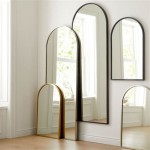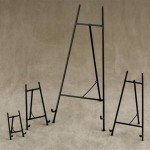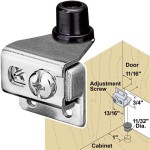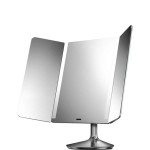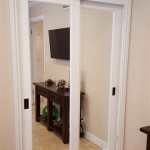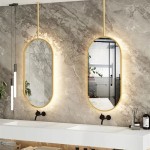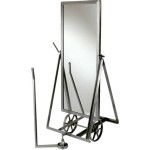How Big Should A Mirror Be Over Sofa: A Comprehensive Guide
Mirrors serve as both functional and aesthetic elements within interior design. Placed strategically, they can enhance the perception of space, amplify natural light, and contribute significantly to a room's overall visual appeal. When selecting a mirror to hang above a sofa, determining the appropriate size is paramount. An improperly sized mirror can disrupt the balance of the room, appearing either too diminutive and insignificant or overwhelmingly large and dominant. This article provides a comprehensive guide to determining the optimal size for a mirror above a sofa, considering various factors to ensure a harmonious and visually pleasing arrangement.
Key Point 1: Proportionality to the Sofa
The primary principle guiding mirror size selection is proportionality to the sofa itself. The mirror should not be so large that it dwarfs the sofa, nor so small that it appears insignificant and lost on the wall. A general rule of thumb is that the mirror should be approximately two-thirds to three-quarters the width of the sofa. This ratio helps to create a balanced and visually coherent arrangement. For example, if a sofa is 84 inches wide, the ideal mirror width would fall between 56 and 63 inches.
This range allows for sufficient visual presence without overpowering the sofa, which is typically the focal point in the seating area. It is important to measure the sofa accurately before beginning the mirror selection process. Consider measuring from the outermost edges of the sofa, including any armrests or decorative elements. This will provide the most accurate measurement for determining the ideal mirror width.
Beyond width, consider the height of the mirror. While width is often prioritized, height contributes to the overall visual impact. A taller mirror can create the illusion of higher ceilings, particularly in smaller rooms. The mirror’s height needs to be considered in conjunction with the wall space available above the sofa, factoring in any existing architectural features, such as crown molding or light fixtures. The height should allow for adequate space between the top of the sofa and the bottom of the mirror, as well as sufficient clearance between the top of the mirror and the ceiling.
Furthermore, the shape of the mirror can influence the perceived size. A rectangular mirror, for instance, will generally appear larger than a round or oval mirror of similar surface area. This is because the elongated shape draws the eye vertically and horizontally, creating a greater visual impact. Consider the shape of the mirror in relation to the overall style of the room and the specific design aesthetic being pursued. A more modern space might benefit from a sleek, rectangular mirror, while a more traditional setting might be better suited to a round or oval mirror with a decorative frame.
Key Point 2: Wall Space and Surrounding Elements
The amount of available wall space above the sofa is another critical factor in determining the appropriate mirror size. Even if a mirror adheres to the two-thirds to three-quarters width rule, it may still appear disproportionate if the wall space is limited or if there are other elements present that compete for visual attention. Consider the height of the ceiling, the presence of windows or doorways, and any other wall decor that might influence the overall arrangement.
If the wall space is relatively small, a smaller mirror may be more appropriate, even if it falls slightly outside the recommended width range. Conversely, if the wall space is expansive, a larger mirror may be necessary to fill the void and create a sense of balance. In such cases, consider using a pair of smaller mirrors instead of a single large one. This can create a more visually interesting arrangement and allow for greater flexibility in terms of placement and spacing.
The style and color of the wall also play a role in how the mirror is perceived. A mirror placed against a dark-colored wall will generally appear more prominent than one placed against a light-colored wall. This is because the contrast between the mirror and the wall draws the eye to the reflective surface. Conversely, a mirror placed against a patterned wall may become visually lost or compete with the pattern for attention. In such cases, consider choosing a mirror with a simple, understated frame to avoid further visual clutter.
Consider the placement of other elements in the room, such as lamps, side tables, and artwork. The mirror should complement these elements, rather than compete with them. For example, if there are two table lamps flanking the sofa, the mirror should be centered between them to create a symmetrical and balanced arrangement. Similarly, if there is a large piece of artwork on an adjacent wall, the mirror should be chosen in a way that does not detract from the artwork's visual impact.
Key Point 3: Functionality and Intended Purpose
The intended function of the mirror also influences the ideal size. Is the mirror primarily intended to be decorative, or is it intended to provide a functional reflection for grooming or checking one's appearance? If the mirror is primarily decorative, the size can be determined more by aesthetic considerations, such as proportionality and wall space. However, if the mirror is intended to be functional, the size should be large enough to provide a clear and unobstructed reflection of the person standing in front of it.
For functional purposes, ensure the mirror's height allows for a full view of the person's head and shoulders. The bottom edge of the mirror should be positioned at a height that allows for comfortable viewing, while the top edge should provide sufficient headroom. This is particularly important in entryways or hallways where mirrors are often used for quick checks before leaving the house. In living rooms, the functional aspect is often less critical, allowing for greater flexibility in terms of size and placement.
Furthermore, consider the type of reflection the mirror will provide. A large mirror can create the illusion of a larger space by reflecting more of the room. This can be particularly beneficial in smaller rooms or apartments where maximizing the perception of space is a priority. Conversely, a smaller mirror may be more appropriate in larger rooms where the goal is not to create the illusion of space, but rather to add a decorative touch and reflect light.
The frame of the mirror should also be considered in relation to its function. A decorative frame can add visual interest and enhance the mirror's aesthetic appeal, but it can also detract from its reflective surface. If the mirror is primarily intended for functional purposes, a simple, understated frame may be more appropriate. Conversely, if the mirror is primarily decorative, a more elaborate frame can be chosen to complement the overall style of the room and add a touch of personality.
When selecting a mirror, it is advisable to use painter’s tape to visualize the size and shape on the wall above the sofa. This helps to assess the proportionality and ensure the chosen dimensions are appropriate for the space. Consider different shapes and sizes to determine which option best complements the sofa and surrounding elements. It may also be beneficial to take photographs of the space and digitally overlay images of different mirrors to further visualize the final arrangement. Ultimately, the best size for a mirror above a sofa is one that balances aesthetic appeal with functional considerations, creating a harmonious and visually pleasing addition to the room.

33 Mirror Above Couch Ideas That Will Add An Instant Depth

Tips On Hanging A Mirror Over Furniture C Home Limited
:strip_icc()/cdn.cliqueinc.com__cache__posts__189779__large-round-mirrors-189779-1528326128816-main.700x0c-6e62240fb50344ed8626b2537ad786fa.jpg?strip=all)
30 Ways To Style Large Round Mirrors

Console Tables And Round Mirrors A Perfect Combination
:strip_icc()/Designer_KatieHackworthPhotographer_BelatheePhotography1-5ec16af89e9242cabd3c637c7eb23d4b.jpg?strip=all)
10 Feng Shui Rules For Mirrors According To Experts

How To Pick The Right Mirror For Your Entryway Gem Picker

Console Tables And Round Mirrors A Perfect Combination

Feng Shui Mirrors In Living Room Tips To Placing Them Right Benefits

Tips On How High To Hang A Mirror For Your Space I Shutterfly
:strip_icc()/cdn.cliqueinc.com__cache__posts__189779__this-neat-trick-makes-your-room-look-bigger-and-chic-1731602-1460589762.700x0c-16b124fc700a4406a2da75d5f6b6766c.jpg?strip=all)
30 Ways To Style Large Round Mirrors
